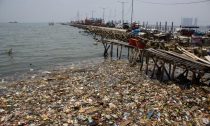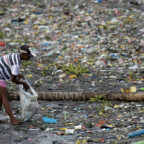
As Earth Day rolls around again, whether we have seen Blue Planet II, or photos of whales and other sea life that have starved on a diet of ingested plastics, we are increasingly aware that ocean plastics are a menacing – and worsening – problem. China’s role in the issue is critical, particularly since an estimated five million tons of the eight million tons of plastic entering the sea each year comes via China. But there are hopeful signs that stricter environmental regulation by Beijing will have a positive impact on ocean plastics.
I should say upfront that my interest in the subject was piqued by Marcy Trent-Long’s terrific podcast, The Eight Million. I was lucky enough to reach plastics expert and Founder of Ocean Recovery Alliance, Doug Woodring, by phone last week before he headed out to kick off the Ocean Film Festival during Hong Kong’s Earth Day celebration. Ocean Recovery Alliance, advocates for a circular plastics economy, through multiple initiatives.
So what are China’s biggest initiatives to date?
China has banned imported waste — Prior to banning “foreign garbage,” China was the world’s biggest recycler, according to McKinsey, importing more than 50% of the global trade for end-of-life plastic. In 2016 alone, China imported about 87% and 69% of Japan and the U.S.’s plastic waste exports. A recycled plastic bottle in Brooklyn or Osaka was very likely to end up in China. China, in turn, was recycling waste plastic to supplement its feedstock of virgin resin to make plastic, of which it was the world’s largest producer (at about 25%). A side note is that now, China’s economy has shifted to higher-grade output and its petrochemicals industry has excess capacity, reducing the need for imported plastics.
JB: Can you explain the implications of China not taking the world’s garbage anymore?
DW: China is doing good stuff and they’re doing way more than the U.S., and they should be congratulated. We should celebrate what’s happened. It’s the shock that the world needed, to onshore technologies and solutions. I call it the “the biggest land-based tsunami” the world has ever seen. And most of the western municipalities have no idea what to do. All are getting hit with the plastics problem that they used to move offshore.
He also notes Australia has said some cities will bury more plastic in landfills as a result. On the other hand, the European Union has responded more thoughtfully, announcing that, by 2030, all plastic packaging (which accounts for about two thirds of the region’s plastic waste) must be recyclable, with a goal of recycling 55% of plastic waste by then.
JB: Why is recycling plastic so expensive?
DW: Only 10% of the world’s plastic gets recycled, there has been a vast under-investment on a global scale to handle the growth in plastic materials. A great analogy of why it’s so expensive is, it’s like re-constituting an omelet. If you make an omelet of eggs, cheese, peppers mushrooms, and someone says, “go reconstitute that to its original form,” that’s the complexity of making plastic valuable.
JB: But we separate our garbage.
DW: The waste systems we have today basically say, “throw everything in a black bag with your food and grease and water and coffee.” It takes the value of all those resources to zero quickly. Unless you sort it right, at the beginning, you will end up with jumbled mush, which is why it costs more to clean, grind and sort all the types of plastic versus just making a virgin batch.
China has mandated 46 cities must begin garbage sorting and reach a 35% recycling rate by 2020 — While there is uncertainty around implementation of the proposed standards, proper sorting into “wet” (think greasy), and dry waste makes a huge difference to recycling economics, separating out organic streams for waste-to-energy and capturing plastic bottles and other high-value recycling plastics that are currently not pulled out by garbage pickers, that end up in the ocean. McKinsey found that even though China imports most of the world’s waste plastic, the extraction rate is only 11% in China, because a ton of plastic bottles take up a lot more space than the metals or even cardboard do, thus increasing the likelihood of perfectly recyclable plastics finding their way into China’s great rivers and then, the ocean. So plastic reduction can happen two ways: the first is that China is getting less, and the second is mandated sorting at source can significantly reduce plastic runoff to oceans — both McKinsey and Woodring agree.
China is building out its waste-to-energy (incineration) capacity — The final way to deal with waste too low value for recycling is to incinerate it — and China is building incineration plants faster than any other nation.
Most experts, including Woodring and McKinsey, favor waste-to-energy for low-value plastics. In his TEDxWanChai talk, Woodring says that 50% of the plastics used today are disposable. Plastic bags, coffee-stirrers, etc. are low value from a recycling perspective. Some 90% of plastic disposable don’t get recycled, often ending up in rivers and oceans where they readily decompose into micro-plastics.
McKinsey estimates that manually sorting high-value plastic waste (assuming China’s municipal recycling mandate is effective) and converting much of the remainder to refuse-derived fuel (RDF) for use in the cement industry, could replace 3% of total coal consumption. That’s impressive. Yet some people have expressed concern about China’s plan to increase waste-to-energy facilities at such a rapid pace — with many concerned that these plants emit pollutants.
How China deals with plastics is just one if its ongoing policy efforts to build an “ecological society.” By taking action, especially through its imports ban, China can help galvanise worldwide efforts to deal with plastics in a more circular way.















Social Profiles